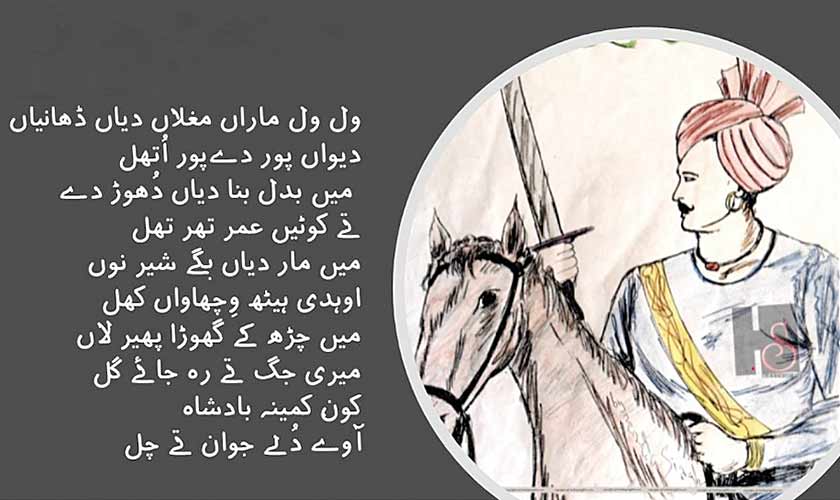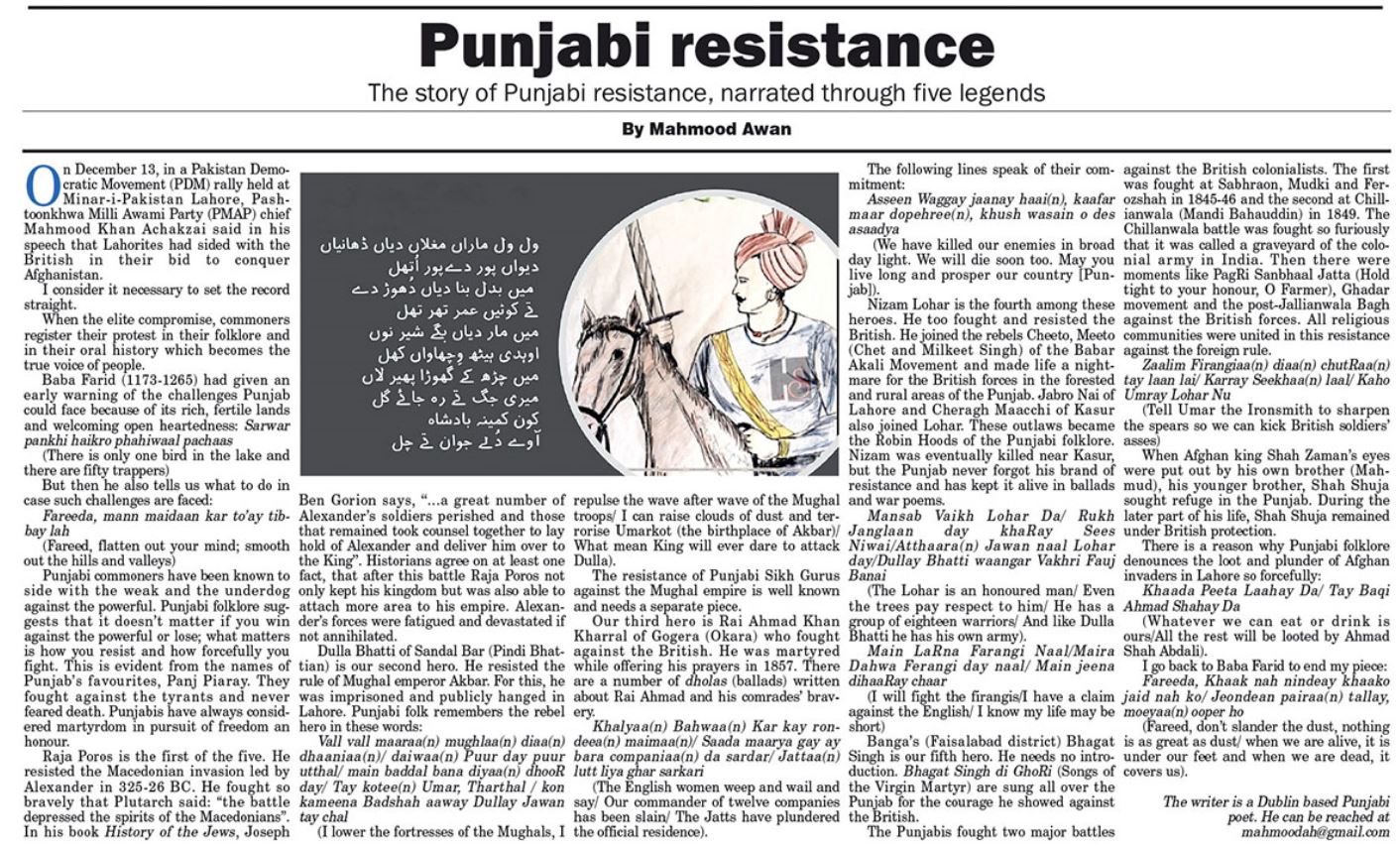Mahmood Awan (The News on Sunday, 20th December 2020)
On 13th December, in a PDM (Pakistan Democratic Movement) rally held at Minar-e-Pakistan Lahore, Pashthoon leader Mahmood Achakzai in his speech insulted Lahories alleging that they sided with British to conquer Afghanistan. Achkzai who considers himself more of an Afghan than a Pakistani, further claimed that Lahoris worked together with Hindus and Sikhs presumably citing this age-old communal harmony as a crime! This all happened in Lahore in front of thousands of Punjabis while Punjabi political elite on stage stayed mum!
Lately these ethno-exclusionists have made Punjab and Punjabis sole target of their hate. They turn more abusive and derogatory while addressing their audiences in their mother tongues. Slants they use for Punjabis could have landed them in prison if they were in any other civilised country but in our land, there are no consequences whatsoever for spewing hatred and falsehood against one particular community.
As this Anti-Punjab propaganda has been put on repeat at all levels, it has become necessary to set the record straight. Unfortunately, such propaganda has got a free run because Punjabis willingly sacrificed their own identity and language for the sake of Federation of the Pakistan. If Punjabis had taken their own history, identity and language seriously then a Pashtoon wouldn’t have dared talk ill about them in front of their own province’s political leadership. Ask Achakzai to say the same against Sindhis in Sindh in front of the Sindhi crowd! You can guess the consequences if he ever tries!
Problem with the Punjab has been that that its elite compromised repeatedly for the sake of their own personal benefits (Pashtoon, Sindhi or Baloch elite is no exception either!). However, when elite compromises, commoners register their protest in their folklore and in their oral history which in turn becomes true voice of common people: honest and uncompromised. In this piece, I will be using Punjabi folklore to show you how resistant Punjab and Punjabis always were against foreign invaders, looters and occupiers.
Baba Farid (1173-1265) had warned us early in our history of the challenges we may face because of our rich, fertile lands and our welcoming open heartedness: “Sarwar Pankhi HaikRo Phahiwaal Pachaas (There is only one bird in the lake and there are fifty trappers) but then our Baba told us what to do if you come across such looters: “Fareeda, Mann maidaan kar to’ay tibbay lah (Fareeda, flatten out your mind; smooth out the hills and valleys).
Punjab and Punjabi commoners followed these instructions and have always sided with the weakest and underdogs against the most powerful. Our folklore and literature tell us that it doesn’t matter to Punjabis if you win against the powerful but what matters is how bravely you resisted and how forcefully you fought. It’s evident from the names of Punjab’s culturally agreed Panj Piaray (Five Legends/Beloveds). All these five legends are those who fought against the tyrants of their time and never feared death. Shaheedi or Martyrdom in pursuit of freedom and dignity of its land and its people is what Punjabis have always considered as an honour.
I will tell the story of Punjabi resistance through these five legends (Panj Piaray) benefitting from Punjabi folklore. 1st of those is Raja Poros who fought against Macedonian invasion lead by Alexander in 325-26 BC. He fought so bravely that Plutarch quoted: ‘the battle depressed the spirits of the Macedonians’. While Joseph Ben Gorion in his book History of the Jews added: ‘.. a great number of Alexander’s soldiers were destroyed and those that remained took counsel together to lay hold of Alexander and deliver him over to the King”. All those contradicting historians agree on one fact that after this battle, Raja Poros not only saved his kingdom but was able to attach more area to his empire which was earlier conquered by Alexander. Whereas Alexander’s forces were fatigued and devastated if not annihilated.
Our 2nd Piara is Dulla Bhatti of Sandal Bar (Pindi Bhattian) who resisted rule of Mughal emperor Akbar, he was imprisoned and publicly hanged in Nakhas Area (now the area of Landa Bazar) Lahore. Punjabi folk remembers his rebel hero Dulla Bhatti in these words: Vall vall maaraa(n) mughlaa(n) diaa(n) dhaaniaa(n) / daiwaa(n) Puur day puur utthal / main baddal bana diyaa(n) dhooR day/ Tay kotee(n) Umar, Tharthal / kon kameena Badshah aaway Dullay Jawan tay chal ( I lower the fortresses of the Mughals, I repluse the wave after waves of the Mughal troops/I can raise clouds of dust and terrorise Umarkot (the birthplace of Akbar) / What mean King will ever dare to attack Dulla). Then resistance of Punjabi Sikh Gurus against Mughal empire is well known and needs a separate piece.
3rd Punjabi Piara is Rai Ahmad Khan Kharral of Gugera (Okara) who fought against British colonial forces and took his area out of their control as long as he lived. He was martyred while offering his prayer in 1857. There are number of Dholas (Ballads) written about Rai Ahmad and his co-fighters’ bravery depicting minute details of the events of his encounters against much bigger force: Khalyaa(n) Bahwaa(n) Kar kay rondeea(n) maimaa(n) / Saada maarya gay ay bara companiaa(n) da sardar / Jattaa(n) lutt liya ghar sarkari (The English Women weep and wail and say / Our commander of twelve companies has been slain/ The Jatts have plundered our offices). Then this line completes the immortal fearless sense of Shaheedi: Asseen Waggay jaanay haai(n), kaafar maar dopehree(n), khush wasain o des asaadya (We have killed our enemies in broad day light. We will die soon too. May you live long and prosper our country [Punjab]).
4th Punjabi Piara is Nizam Lohar who also fought and resisted British Colonialists. He joined rebels Cheeto, Meeto (Chet and Milkeet Singh) of the Babar Akali Movement and made life of British forces a nightmare in forested and rural areas of the Punjab. Jabro Nai of Lahore and Cheragh Maacchi of Kasur also joined Lohar, and these outlaws became Robinhoods of Punjabi folklore. He was eventually killed near Kasur, but Punjab never forgot his brand of resistance and kept all of them alive in the Ballads and War Poems: Some of the popular folk lines are: Mansab Vaikh Lohar Da / Rukh Janglaan day khaRay Sees Niwai / Atthaara(n) Jawan naal Lohar day/Dullay Bhatti waangar Vakhri Fauj Banai ( The Lohar is a much honoured man/ Even the trees pay respect to him/ He has a group of eighteen warriors/ And Like Dulla Bhatti he has his own army). Another popular folk line is Main LaRna Farangi Naal/Maira Dahwa Ferangi day naal / Main jeena dihaaRay chaar (I will fight with the Ferangies/I have a claim against the English/ I know my life may be short).
5th Punjabi Piara is Banga (distt. Faisalabad) born Shaheed Bhagat Singh who needs no introduction. Bhagat Singh di GhoRi (Songs of the Virgin Martyr) are sung all over Punjab for the courage he showed to resist British Colonial occupation.
While insulting Punjabis, Achakzai forgot that it was Punjabis who fought two major battles against British colonialist’s and bloodied their nose. 1st War was fought at Sabhraon, Mudki and Ferozshah (1845-46) and 2nd at Chillianwala (Mandi Bahauddin) in 1849. Chillanwala battle was so furiously fought by Punjabis that it was called a Graveyard of Colonial Army in India. Achkazai may not have heard of Movements of PagRi Sanbhaal Jatta (Hold tight to your honour, O Farmer), Ghadar movement and Post-Jallianwala Bagh rebellions against British forces. Beauty of the land of five rivers was that all religious communities were together in this resistance against the foreign rule. One of the Ghaddar verse raises goosebumps: ‘Zaalim Ferangiaa(n) diaa(n) chutRaa(n) tay laan lai / Karray Seekhaa(n) laal/ Kaho Umray Lohar Nu ( Tell Umar the Ironsmith to sharpen the spears so we can kick British soldiers’ s asses).
These are just few examples of Punjabi resistance against invaders and power-hungry rulers. Achakzai must have known that when his Afghan king Shah Zaman’s eyes were put out by his own brother, his namesake Mahmud, then Zaman’s younger brother, Shah Shuja came running to Punjab to plead for military assistance from Ranjit Singh as well as from British Colonialists across Sutlej. Same Shah Shuja was later given refuge by the Punjabi King in Lahore when he fled Afghanistan for his life with his and his blind brother Shah Zaman’s family in 1813! Later part of his life, Shah Shuja remained under British protection begging them to be reinstated as King in Afghanistan.
Therefore, while speaking in Lahore, it would have been much better if instead of insulting Lahories, Achakzai would have thanked them for giving refuge to his Afghan King. He also could have opted to apologise on behalf of his invading Afghan ancestors for looting and plundering Lahore, Punjab and Punjabis in the name of Islam. These invaders used Islam as a political pre-text to loot and plunder our fertile lands and people. Nadir Shah’s deceitful and full of lies letter dated Jamdi-ul-Awal 1151 Hijri (1738) to Muhammad Shah using Islam as his reason to invade (and kill fellow muslims) is one such example of betrayal.
Punjab and Punjabis knew that deceit well and there is a reason Punjabi folklore denounces so forcefully these killers coming from Afghanistan: Khaada Peeta Laahay Da/ Tay Baqi Ahmad Shahay Da (Whatever we can eat or drink is ours/All the rest will be looted by Ahmad Shah Abdali). Waris Shah (1722-1798) our greatest Poet who lived through Abdali’s eight invasions on Punjab from 1748-1768 was so disgusted that he equated him and his co-invaders with dogs: He wrote in his epic Heer: KhaiRay Kabli Kuttyaa(n) Waang Ithay Wadhwa Kay Nakk Tay Kann Ga’ay..کھیڑے کابلی کتیاں وانگ ایتھے وڈھوا کے نک تے کن گئے۔ KhaiRas ( Heer’s In laws, a Jat tribe) were humiliated like Punjabis humiliated those invading Dogs of Kabul.
This immense abuse, hate, and killings (especially in Balochistan) which common Punjabis have suffered in last two decades from the hands of these ethno-exclusionist elements just because of their ethnicity is taking a toll on all of us. This must end, and the native Punjabi collaborators, facilitators and silent elite must take note otherwise, our folklore tells us clearly how they will be remembered!
In this grievous moment, allow me to go back to Baba Farid to end my rebuttal to Achakzai: Fareeda, Khaak nah nindeay khaako jaid nah ko / Jeondean pairaa(n) tallay, moeyaa(n) ooper ho ( Fareed, don’t slader the dust, nothing is as great as dust/ when we are alive, it is under our feet and when we are dead, it is above us).
A shorter version of the piece was published on 20th December 2020 in The News on Sunday.
https://www.thenews.com.pk/tns/detail/760627-punjabi-resistance


